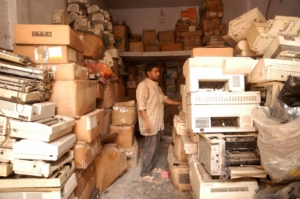Fix the E-Waste Problem: New Life for Used Electronics
 E-waste is a general term for discarded electronic components that contains everything from cell phones to disk drives. It is causing a crisis in the developing world. Only 12.5% are recycled worldwide. E-waste is different from other forms of trash because electronic waste contains toxic metals like lead and cadmium leach into groundwater sources if not properly managed. This is common in developing countries, where nations simply do not have the resources to properly limit water and air pollution. It is time to fix the e-waste problem.
E-waste is a general term for discarded electronic components that contains everything from cell phones to disk drives. It is causing a crisis in the developing world. Only 12.5% are recycled worldwide. E-waste is different from other forms of trash because electronic waste contains toxic metals like lead and cadmium leach into groundwater sources if not properly managed. This is common in developing countries, where nations simply do not have the resources to properly limit water and air pollution. It is time to fix the e-waste problem.
The Problem
The processing of e-waste is difficult because of the many elements in computer chips and other techs. Paper, a major component of traditional solid waste, is recycled 64.7% of the time because the methods to get the paperback are just that much easier. The United Nations claims that 10-40% of the total e-waste from America goes abroad to countries in Asia. In addition, as little as 0.13% of all waste properly disposed of there. India is starting to make its own e-waste with the growth of the middle class. This leads to many unseemly sights in places like Taiwan, China and Pakistan.
One PBS reporter’s finding of a large lot stacked 5m high – just with printers. Workers, who are women and children, use unsafe and known to be carcinogenic chemicals like sulfuric acid to dissolve the plastic in the printers. People do get gold and silver out of this process. However, this comes at great cost to themselves and their communities, as breaking down this waste contributes to pollution. WHO estimates that one in four people die worldwide due to complications with contamination. Additionally, the way we manage e-waste certainly is not helping.
What Can We Do With Our Used Electronics?
The problem seems overwhelming and hard to solve. However, many companies and NGOs alike are tackling the issue. After e-waste is managed correctly, it has the potential to make or save money. There are three main ways to improve the health of people in Asia with respect to discarded electronics, and in the following order:
- Reduce. Samsung, a well-known company based in South Korea, wants to make their products last longer. Although there are short-term benefits for having customers update their technology every few years, the corporation externalizes costs of what to do with those electronics after people use them to poorer nations. This leads to public relations issues and potentially a loss of profit. It plans to increase life by creating places where people can repair their phones and larger appliances. Also, people can change the design to make sure components do not break in the first place.
- Reuse. Many people in countries where e-waste is going do not have internet access. Why not refurbish old devices from developed countries to expand access? This extends the life of technology which should ultimately reduce the amount that ends up discarded. Furthermore, one charity that sends technology worldwide is InterConnection. Unfortunately, some security risks rise with this. Since computer data is very hard to wipe, the data in electronics can end up in the wrong hands.
- Upcycle. Not only recycling, but upcycling is a promising way to fix the e-waste problem. Upcycling turns products into something with more value, not less as is the case with paper or plastic when they’re made into something new. For example, the gold in the NoWa necklace is entirely from discarded cell phones. Promoting safe labor practices to make these pieces can also prevent situations like what happened with the printers in Vietnam.
Solving large problems like fixing the e-waste problem may seem daunting. If we think creatively, we can make the world a better place by encouraging our countries to make smart and informed decisions about how to responsibly manage hazardous materials from used electronics.
– Michael Straus
Photo: Flickr
